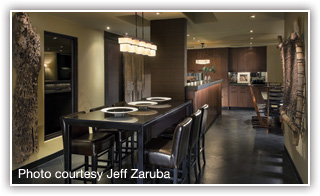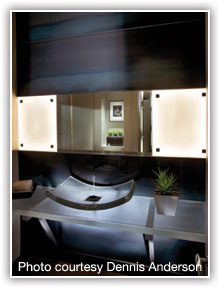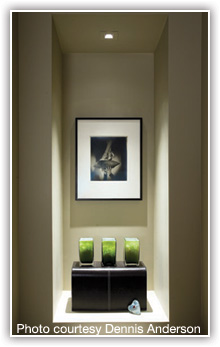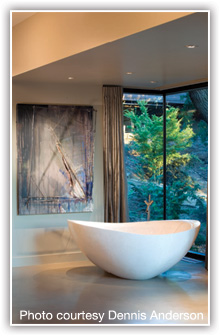By Randall Whitehead, IALD
I’m a lighting designer who specializes in interior and exterior residential projects. I work with kitchen and bath designers, architects, interior designers, and homeowners to help make their projects come to life at night.

My home, which is located down the street from my office, gets used as a living light lab to show off the latest techniques and products to prospective clients. Since I promote energy-efficient lighting to others, it only seemed right to install it in my own home. All the lighting there is energy efficient, except for the two incandescent lamps in my fridge and oven.
Let’s face it—people have an inherent fear and loathing of fluorescent lighting… and little knowledge of LEDs (light emitting diodes) or CCFLs (cold cathode fluorescent lamps). Allowing them to experience these sources in an actual installation helps them see that energy-efficient lighting can also be alluring. Seeing is believing.
What’s the Buzz?
The compact fluorescent lamps (CFLs) sold in the big box stores and home improvement stores are the worst of the lot. The incentive was to offer a CFL for the cost of an incandescent light bulb. These low-cost lamps have a premature burnout rate, buzz, and are not dimmable. There are wonderful CFLs out there, but they cost around $12. Even at this price, they’ll save around $72 in energy costs over the life of the lamp. Top-of-the-line screw-in CFLs and CCFLs offer a dimmable light source (down to 30 percent) that can be controlled by a standard incandescent dimmer.

CCFLs have been around for awhile, but have stayed a bit under the radar. The glass tubing is very small, about the diameter of cooked spaghetti. This enables the tubing to be enclosed inside a outer glass envelope that looks very much like a standard incandescent lamp, flame tip, or globe lamp. They have full range dimming with an incandescent dimmer and last 18,000 to 25,000 hours. Presently, the maximum wattage you can get is 8 watts, which produces the illumination equivalent of 45 watts from an incandescent bulb. They take about 10 seconds to come up to full brightness, though. I have them in all of my decorative fixtures. They come in a variety of color temperatures, but my favorite is the 2250K, which has a very warm, incandescent glow. Nobody ever thinks that it’s a fluorescent source.
For those of you who aren’t so sure of using any kind of CFLs due to their mercury content, there’s a new fluorescent-like lamp on the horizon called the ESL (electron stimulated luminescence). It will have no mercury, full range dimming and instant-on, like a standard incandescent. Hopefully, it will be out this year.
You may not know that LEDs have been around since the 1960s. Until recently, they were essentially used as brightly colored indicator lights. About three years ago, manufacturers developed an LED source with the warm qualities of incandescent light. These newly developed LEDs use less electricity than standard incandescent sources. Many LEDs are available in dimmable versions, and some fixtures on the market can meet California’s strict Title 24 energy code, which dictates that 50 percent of the wattage in kitchens must be hard-wired high-efficacy lighting. Bathrooms must be 100 percent high efficacy or controlled by a switched motion sensor.
LEDs can last from 30,000 to 50,000 hours, while emitting no ultra-violet radiation; they also contain no trace amounts of mercury like fluorescents do. Some companies offer screw-in and hard-wire LED kits as retrofits for existing housings; as well as IC-rated, airtight housings for new construction. LED versions of low voltage MR16 lamps are able to beautifully highlight paintings or sculpture without any harmful UV light hitting the art. Even those energy-eating xenon or halogen festoon lamps in the under-cabinet task lights and shelf light come in LED versions that are dimmable.
Another option for under-cabinet task lighting would be a series of LED puck lights or fluorescent puck lights. Flexible low-voltage LED strip lights and easy-to-install line voltage strip lights offer fresh alternatives for task and indirect light.

Decorative Fixtures Companies to Check Out
Many lighting manufacturers are now offering decorative fixtures in modern and traditional styles that have hardwired fluorescent sources. Many are using the new GU-24 socket and CFL technology, which is no bigger than a standard household bulb and socket assembly. These GU24 lamps with their proprietary sockets meet those pesky Title 24 requirements.
Many of your favorite lighting companies may now offer the fixtures you already love in fluorescent versions, so give them a call or talk to their reps about what they have available.
The Secret Sauce
We always incorporate light layering into all our lighting designs, blending decorative, task, accent, and—most importantly—ambient light. Ambient light (indirect lighting) softens the shadows on people’s faces, which helps them look more relaxed and youthful… like architectural Botox.
My recommendation when specifying a luminaire with an energy-efficient light source is to choose decorative fixtures with shades, or recessed fixtures with translucent lenses that hide the lamp. I like to call it stealth green lighting design. If people see a bulb that looks like soft ice cream, they automatically hate it. They just can’t get over their fear of fluorescents.
If the lamp is out of sight…then it’s out of mind.

Randall Whitehead is an internationally known architectural lighting designer whose work has appeared in Architectural Digest, Art & Antiques, House Beautiful, Kiplinger’s, Metropolitan Home, Better Homes & Gardens, Fine Homebuilding, and many more. He regularly appears as a guest expert on the Discovery Channel, CNN, HGTV, and Martha Stewart Living Radio, and writes a monthly column called “The Last Word in Lighting” for Residential Lighting Magazine. Randall has written seven books on lighting, including Residential Lighting, A Guide to Beautiful and Sustainable Design. For more information, visit www.randallwhitehead.com.







